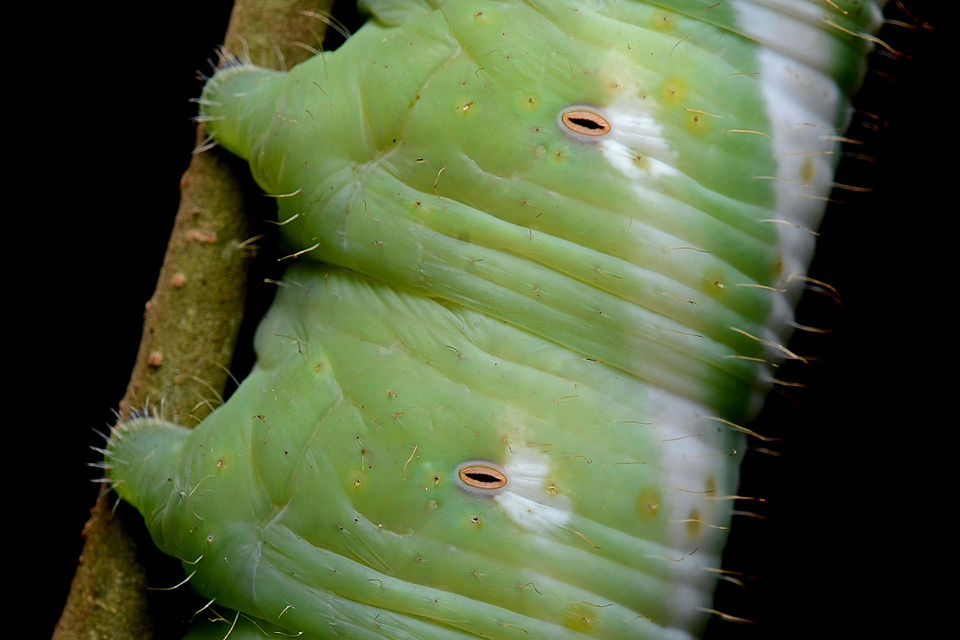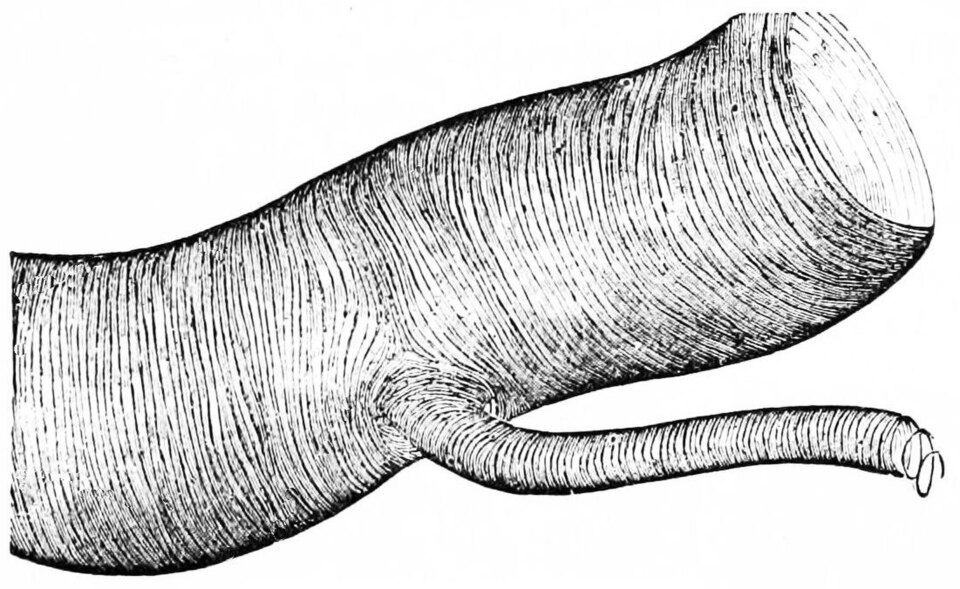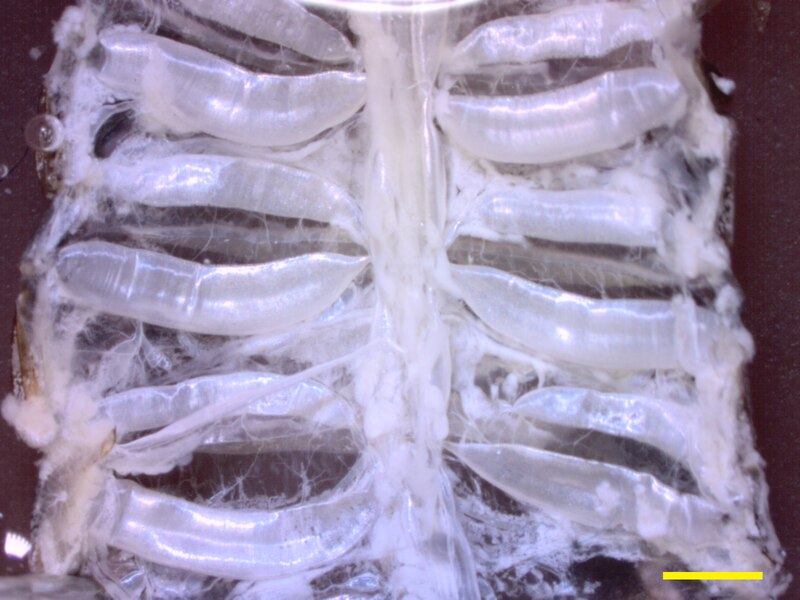OCR Specification focus:
‘Spiracles lead to tracheae and tracheoles; thoracic and abdominal movements change body volume, and exchange occurs with tracheal fluid within tissues.’
Insects rely on a highly efficient gas exchange system independent of blood transport, using air-filled tubes and body movements to deliver oxygen directly to tissues.
The Insect Gas Exchange System
Overview
Insects are small terrestrial arthropods that require a specialised system for ventilation and gas exchange. Their system operates independently of a circulatory system and uses air-filled tubes called tracheae to deliver oxygen directly to tissues. This adaptation minimises water loss and ensures rapid oxygen diffusion, essential for active flying and terrestrial lifestyles.
Structural Components of the Insect Gas Exchange System
Spiracles
Spiracles are small external openings on the thorax and abdomen that act as entry and exit points for gases.
They can open and close via valves controlled by muscular contractions to balance gas exchange and minimise water vapour loss.

Close-up photograph of larval spiracles on a sphingid caterpillar. Spiracles are valved openings that regulate gas movement and help limit evaporative water loss. The photo is a real specimen (no labels), suitable for illustrating external spiracle structure. Source.
Spiracle: A small external pore on the body surface of an insect that allows gases to move in and out of the tracheal system.
When environmental humidity is low or the insect is inactive, spiracles close to conserve water; during activity, they open wider to meet oxygen demands.
Tracheae
The tracheae are large internal tubes leading from the spiracles into the body. They are supported by spiral rings of chitin to prevent collapse and maintain airflow even under pressure changes.

Engraved diagram of a fly trachea highlighting spiral chitinous thickenings (taenidia) that brace the tube against collapse during pressure changes. This structural feature underlies airflow stability in insect ventilation. As a 19th-century illustration, styling is minimal but directly aligned with the required concept. Source.
Trachea: A large chitin-lined air tube in insects that transports gases from spiracles deeper into the body.
Chitin, being impermeable to gases, ensures that diffusion occurs only through the open ends and smaller branches rather than through the walls of the tracheae.
Tracheoles
The tracheae subdivide into fine tracheoles, which are microscopic tubes that extend to individual cells. Tracheoles have thin, moist, and permeable walls that facilitate direct gas diffusion between air and tissues.
Tracheole: A fine, thin-walled tube branching from a trachea that delivers oxygen directly to cells and removes carbon dioxide.
At the ends of tracheoles lies tracheal fluid, which partially fills the lumen. The position of this fluid changes depending on the insect’s activity level, helping to regulate diffusion efficiency.

Dissection image of Nauphoeta cinerea showing the pale tracheal trunks coursing laterally across the body; scale bar 2 mm. This provides direct evidence of the air-filled tubing that conducts gases to tissues in insects. The image is a real specimen and may show surrounding tissues beyond the respiratory system (extra detail not required by the syllabus). Source.
Mechanisms of Gas Exchange in Insects
Diffusion at Rest
When insects are at rest:
Oxygen from the air diffuses down a concentration gradient through the tracheae and tracheoles into the cells.
Carbon dioxide diffuses in the opposite direction — from cells to tracheoles to tracheae and out through spiracles.
The diffusion gradient is maintained as metabolic activity continuously consumes oxygen and produces carbon dioxide.
Because oxygen solubility in tracheal fluid is limited, only the cells near tracheoles are actively supplied, ensuring efficient diffusion over very short distances.
Ventilation Movements
Many insects supplement diffusion with mechanical ventilation to increase airflow and maintain concentration gradients.
Thoracic and abdominal movements alter body volume, causing pressure changes that move air in and out of the tracheal system:
When the abdomen expands, internal pressure decreases, drawing fresh air in through open spiracles.
When the abdomen contracts, internal pressure increases, forcing air out through other spiracles.
These movements act similarly to ventilation in mammals, maintaining a continuous flow of gases without relying solely on passive diffusion.
Active Ventilation in Larger or Flying Insects
Highly active insects such as locusts or bees use additional strategies:
Rhythmic abdominal pumping to accelerate airflow.
Coordinated spiracle opening and closing to direct airflow efficiently through the tracheal network.
Air sacs (expanded tracheae) that compress and expand during movement, pushing air deeper into the body.
Such mechanisms ensure adequate oxygen supply during high-energy activities like flight or thermoregulation.
Regulation of Gas Exchange and Water Conservation
Spiracle Control
Spiracles have muscular valves that regulate gas exchange:
Open spiracles allow ventilation during activity, maximising oxygen intake.
Closed spiracles prevent water loss during rest or dry conditions.
Some insects exhibit discontinuous gas exchange cycles (DGCs), alternating between closed, fluttering, and open phases. This optimises oxygen uptake while limiting desiccation risk.
Role of Tracheal Fluid
At rest, tracheal fluid partially blocks the ends of tracheoles, reducing diffusion but minimising water loss.
During activity, oxygen demand rises, and lactic acid accumulates in tissues, lowering the water potential of cells. This causes the tracheal fluid to move into the surrounding tissues, shortening the diffusion path and allowing faster gas exchange.
Adaptations for Efficient Gas Exchange
Efficient gas exchange surfaces in insects display three essential adaptations:
Large surface area: Provided by the extensive branching of tracheae and tracheoles.
Short diffusion distance: Achieved through the microscopic diameter and close proximity of tracheoles to cells.
Steep concentration gradient: Maintained by ventilation and constant cellular respiration.
Additionally, the waterproof exoskeleton (cuticle) reduces water loss but necessitates an internal gas exchange system, as diffusion through the cuticle alone would be insufficient.
Environmental and Behavioural Adaptations
Insects inhabiting diverse environments exhibit modifications of this system:
Aquatic insects like mosquito larvae use breathing tubes (siphons) or plastrons — air films trapped by hairs — to access atmospheric oxygen.
Burrowing insects reduce spiracle openings to avoid dust blockage and desiccation.
Flying insects possess well-developed air sacs and enhanced ventilation capacity for sustained oxygen delivery during flight.
Such adaptations demonstrate the versatility of the insect tracheal system in balancing metabolic demands with environmental challenges.
Summary of Key Processes
Gas flow sequence:
Air enters through spiracles.
Travels along tracheae.
Diffuses through tracheoles.
Oxygen diffuses into cells; carbon dioxide diffuses out.
Expelled gases leave through open spiracles.
Ventilation is achieved by:
Rhythmic body movements altering thoracic and abdominal volumes.
Coordinated opening and closing of spiracles.
Compression and expansion of air sacs to enhance airflow.
This fully integrated system ensures insects meet their respiratory demands efficiently while conserving precious water in terrestrial habitats.
FAQ
Higher temperatures increase the kinetic energy of gas molecules, speeding up diffusion through the tracheal system. This allows oxygen to reach tissues more rapidly and carbon dioxide to be expelled faster.
However, if temperatures are too high, water loss through spiracles increases, leading to desiccation risks. Insects may respond by closing spiracles more frequently, which can temporarily limit oxygen intake despite the faster diffusion rate.
Air sacs are expandable regions of the tracheal system that act like bellows to enhance ventilation efficiency, particularly in larger or more active insects.
During expansion, air sacs draw in fresh air through open spiracles.
During compression, air is pushed deeper into the tracheal network.
This mechanism supports unidirectional airflow and helps maintain steep oxygen gradients, especially during sustained activity such as flight or thermoregulation.
DGCs are a periodic breathing pattern observed in certain insects to balance oxygen intake with water conservation.
A typical cycle has three phases:
Closed phase: Spiracles shut, preventing water loss.
Flutter phase: Spiracles briefly open and close to admit small amounts of oxygen.
Open phase: Spiracles open widely to expel accumulated carbon dioxide.
This rhythmic control conserves water while still meeting metabolic demands.
Aquatic insects employ several adaptations:
Plastrons (air films) trap a thin layer of air around the body, allowing diffusion between water and the trapped air.
Breathing tubes (siphons) connect to the surface to draw in atmospheric oxygen.
Some have cutaneous gas exchange across thin areas of the exoskeleton.
These adaptations maintain oxygen supply while minimising nitrogen loss and structural collapse of air spaces underwater.
The tracheal system relies on diffusion, which becomes inefficient over large distances. As body size increases, diffusion pathways lengthen and oxygen delivery slows.
Because insects lack a circulatory transport of oxygen, diffusion alone restricts their maximum viable size.
Some prehistoric insects were larger due to higher atmospheric oxygen levels, which increased diffusion rates and allowed larger tracheal systems to function effectively.
Practice Questions
Question 1 (2 marks)
Describe how gases enter and leave the gas exchange system of an insect.
Mark Scheme:
Air enters and leaves through spiracles on the insect’s body surface. (1)
Gases then move through the tracheae and tracheoles by diffusion down a concentration gradient. (1)
Question 2 (5 marks)
Explain how the structure and function of the insect tracheal system enable efficient gas exchange, and describe how insects reduce water loss while exchanging gases.
Mark Scheme:
Tracheae are lined with chitin for structural support, preventing collapse and maintaining open airways. (1)
Tracheoles have thin, permeable walls providing a short diffusion distance to cells. (1)
Large number and branching of tracheoles create a large surface area for diffusion. (1)
Ventilation movements of the abdomen or thorax maintain a steep concentration gradient for oxygen and carbon dioxide. (1)
Spiracle valves can open and close to reduce water loss during rest or in dry conditions. (1)
(Any five correct points; accept equivalents in correct biological context.)

